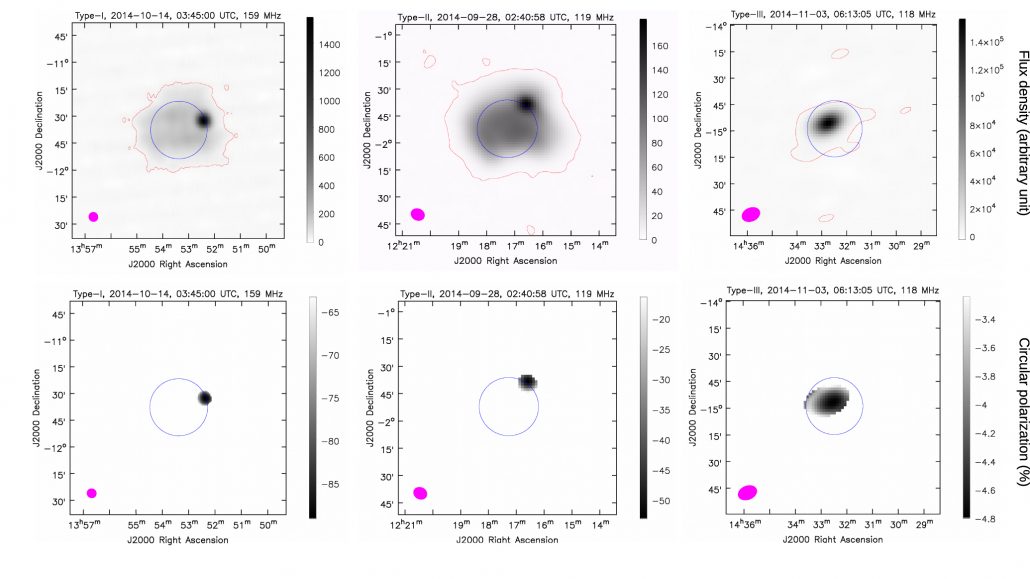The solar corona comprises hot magnetized plasma. Coronal magnetic fields are well known to be one of the crucial parameters determining the physics of the solar corona and are vital drivers of Space Weather. Despite the fact that the importance of coronal magnetic fields has been recognised for a long, in practice, they remain rather hard to measure. The polarization properties of coronal emission at low radio frequencies can, in principle, be used to measure the coronal magnetic field. Precise polarimetry at these frequencies is intrinsically hard and it is made even more challenging by the very large range of brightness temperatures associated with different emission mechanisms (ranging from 10,000 K to 10,000 billion K), the variation in the fractional polarisation from close to 100% to less than 1%, and the extreme temporal and spectral variability of the emission. Very often the very bright emissions are present simultaneously with the very faint emissions. To detect both of them in the radio images, one needs high dynamic range solar images. With the unique array configuration of the Murchison Widefield Array (MWA), a Square Kilometre Array Observatory (SKAO) precursor, it is possible to make high fidelity and high dynamic range spectroscopic snapshot solar images. To achieve this, we developed a robust and automated polarisation calibration and imaging algorithm. Named Polarimetry using Automated Imaging Routine for Compact Arrays for the Radio Sun (P-AIRCARS), this algorithm delivers high dynamic range and high fidelity full Stokes solar radio images with residual leakages on par with the best images today. The algorithm has been developed with the future SKAO in mind. Images made by P-AIRCARS enable the exploration of previously inaccessible phase space and offer a considerable discovery potential.
A brief overview of P-AIRCARS algorithm
The P-AIRCARS algorithm is based on the Measurement Equation framework, which forms the basis of all modern radio interferometric calibration and imaging. For precise polarisation calibration, one has to correct each of the instrumental effects in detail and with sufficient accuracy. The aperture array nature of the MWA and its wide field-of-view restricts the use of calibrator observation to correct for the instrumental polarisation precisely. To overcome this challenge, this algorithm uses the modeled full Stokes primary beam of the MWA and the fact there is no linearly polarised emission from the quiet Sun, and the level of circular polarisation is expected to be less than 1% at the meter wavelengths, to calibrate the instrumental polarisation. We have used full Jones calibration software to perform polarisation self-calibration, which improves the fidelity and dynamic range of the final images.

Figure 1. A sets of Stokes I and circular polarisation images of type-I, II and III solar radio bursts made using P-AIRCARS. Top panel shows the Stokes I images and bottom panel represents the circular polarisation fraction images.,
Results
This algorithm provides full Stokes solar spectroscopic snapshot solar images with high fidelity. This algorithm routinely produces images with a dynamic range of more than 300 under quiet Sun conditions and under certain favorable instances can exceed 105. The residual instrumental polarisation delivered by the algorithm is generally less than 1%, on par with the high-quality radio astronomical observations. The precise polarisation calibration and high dynamic range of these images will enable us to detection of faint radio emissions from the plasma of the coronal mass ejections and the induced circular polarisation of the quiet Sun thermal emission. Some sample P-AIRCARS images of the total intensity and circular polarisation for the type-I, -II, and -III solar radio bursts are shown in the figure 1. The red contour in the top panels shows the Stokes I emission at 0.5% of the peak emission while the bottom panels show percentage circular polarisation. The blue circles represent the optical disc of the Sun and the filled ellipses, the resolution of the observations. In all cases, the residual instrumental polarisation is less than 1%. This algorithm represents the state of the art and has been designed to fulfill the requirement for the precise polarisation calibration of the future Square Kilometre Array.
Based on a recent paper by Kansabanik, D., Oberoi, D. And Mondal, S. 2022, ApJ 931 110 https://doi.org/10.3847/1538-4357/ac6758
Additional info
Full list of authors: Devojyoti Kansabanik 1, Divya Oberoi 1, Surajit Mondal 2,1
1 National Centre for Radio Astrophysics, Tata Institute of Fundamental Research, Pune, India
2 Center for Solar-Terrestrial Research, New Jersey Institute of Technology, Newark, USA
